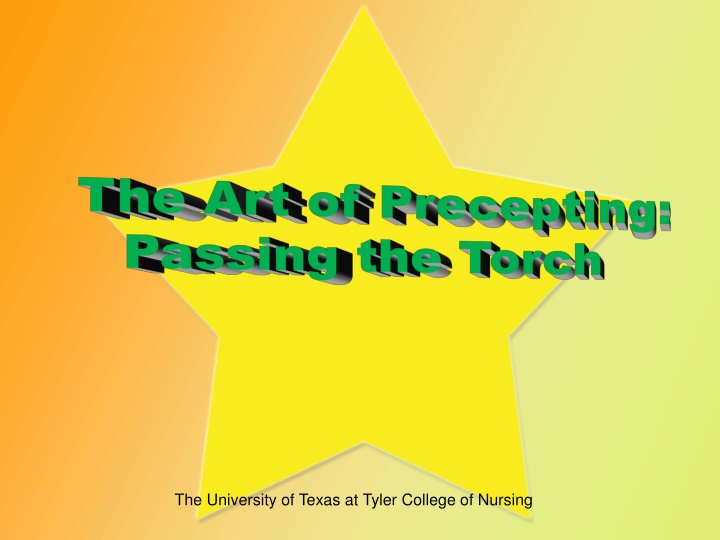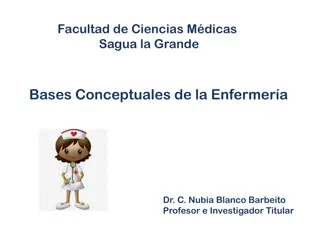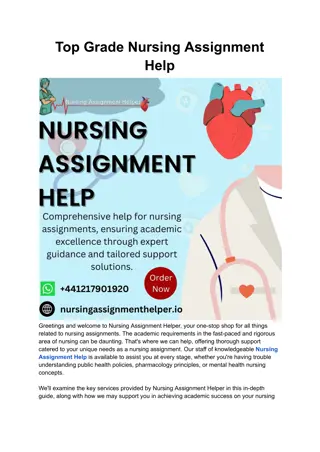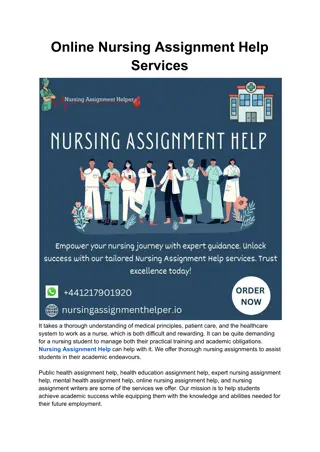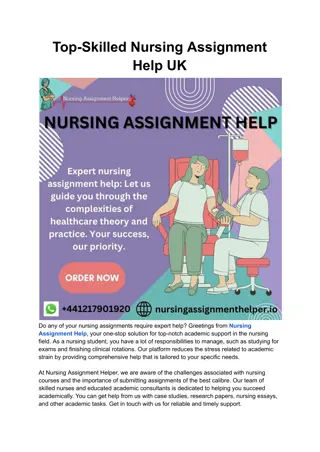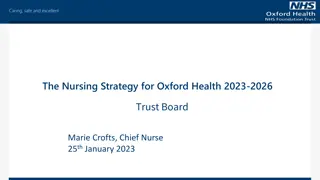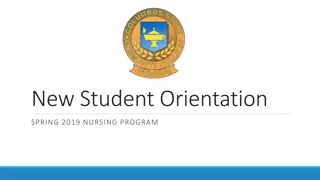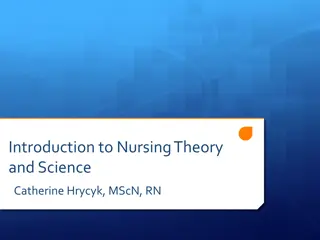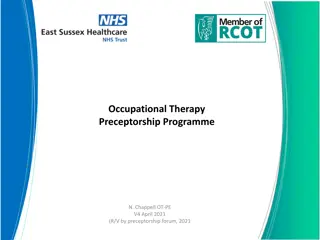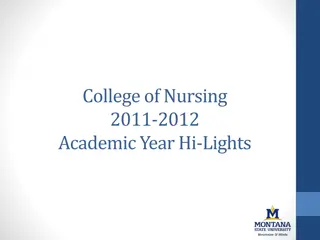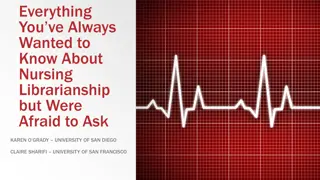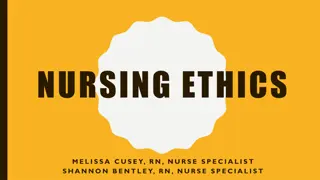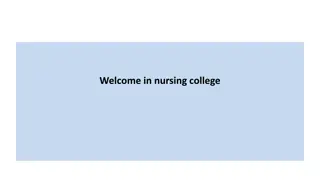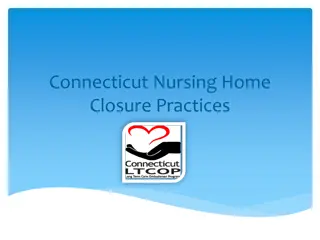Preceptorship Training at the UT Tyler College of Nursing
Explore the role and responsibilities of a preceptor, understand adult learning principles, enhance communication skills, and stimulate critical thinking in the context of nursing education at the UT Tyler College of Nursing. Discover the qualities of a nurse role model and the challenges faced in balancing caregiving and preceptorship roles. Learn about the phases of reality shock in a new orientation.
Download Presentation

Please find below an Image/Link to download the presentation.
The content on the website is provided AS IS for your information and personal use only. It may not be sold, licensed, or shared on other websites without obtaining consent from the author.If you encounter any issues during the download, it is possible that the publisher has removed the file from their server.
You are allowed to download the files provided on this website for personal or commercial use, subject to the condition that they are used lawfully. All files are the property of their respective owners.
The content on the website is provided AS IS for your information and personal use only. It may not be sold, licensed, or shared on other websites without obtaining consent from the author.
E N D
Presentation Transcript
PARTICIPANT PARTICIPANT GOALS GOALS Learn preceptor role & responsibilities Understand how adults learn Explore effective communication, how to give feedback & conflict resolution Discuss techniques for stimulating critical thinking Review components of the UTT CON preceptor handbook Complete preceptor post-test The University of Texas at Tyler College of Nursing
Role Model--demonstrates how competent staff perform their job--most familiar, most comfortable Socializer--helps preceptee feel welcome & integrated into the unit culture--less familiar, less comfortable Educator--helps preceptee assess orientation learning needs, plan learning experiences, implement the plan, evaluate performance-- least familiar, least comfortable Educator The University of Texas at Tyler College of Nursing
Role Model-- an individual who exemplifies through his or her behavior how a specific role is to be enacted (JG Alspach, 2000) Nurse role model exhibits these qualities-- Caring Positive interactions Empathetic Respected by peers Good communicator Strong patient advocate Expert practitioner Willing resource person Shares knowledge with others Respects dignity in all people Critical thinker Honest, accountable The University of Texas at Tyler College of Nursing
Compare--your usual job activities with teaching others how to perform their job Major Role with Preceptee-- teaching rather than doing Conflict--can arise if you do for the preceptee rather than guiding to do for themselves Challenge--balancing dual role of caregiver and preceptor The University of Texas at Tyler College of Nursing
Think back to your own orientation-- how you felt, new circumstances Reality Shock--4 phases HONEYMOON SHOCK RECOVERY RESOLUTION The University of Texas at Tyler College of Nursing
Adult Learning Principles How Communication is Received Generational Values Learning Styles The University of Texas at Tyler College of Nursing
Self-directed--want to be actively involved Relate new knowledge to life experiences/previous knowledge Goal-oriented Must have a reason for learning Practical--want learning to be useful Want to state their views, be recognized, be accepted, feel important, be respected The University of Texas at Tyler College of Nursing
Words 60% 30% Hearing 10% Content The University of Texas at Tyler College of Nursing
MATURES--<1946-- duty work ethic, follow orders, productive, fixers BABY BOOMERS--1946-1964--teamwork, process oriented, desire recognition, uncomfortable with conflict GENERATION Xers--1965-1980--self-reliant, skeptical, casual about authority, tech savvy, resourceful MILLENIALS--1981-2000--tech savvy, less focused on problem solving & more on choices, buy into team concept, look for mentors, accepting of other cultures, expect management to be competent, demand equity The University of Texas at Tyler College of Nursing
Left Brain vs. Right Brain Analytical Uses automatic codes Arranges details in order Auditory rather than visual LEFT Global Wholes, not parts Novelty Intuitive Spatial Visual over auditory RIGHT The University of Texas at Tyler College of Nursing
Goal: To IMPROVE Performance I Identify learning objectives M Make a feedback-friendly learning environment P Performance--assess it R Respond to your learner s self-assessment O Objectivity--always keep it V Validate good work, suggest alternatives in weak areas E Establish a plan The University of Texas at Tyler College of Nursing
Feedback should be Immediate Clear Positive Objective The University of Texas at Tyler College of Nursing
Task Interdependence Individual Differences Scarce Resources Poorly Designed Reward Systems Communication Failures Goal Incompatibility The University of Texas at Tyler College of Nursing
Take responsibility Agree to disagree Define the problem Allow venting Establish ground rules--honesty, everyone will be heard, all listen, support feelings with facts Ask open-ended questions Listen objectively Restate problem, set goals, establish action plans Follow-up The University of Texas at Tyler College of Nursing
Create a climate of curiosity/questioning Ask Open-ended vs. Close-ended questions, qualify answers--correct, partially correct, incorrect Prepare for the unexpected-- What if Think out loud--Verbalize your processes Compare assessment findings with report Reflect on activities/findings of the day Challenge assumptions Seek meanings, connections, group data Keep professional humility--readily admit erroneous conclusions, seek the truth always The University of Texas at Tyler College of Nursing
1 Plan aheadtell staff date preceptee is coming to unit, outline daily plans 2 First day ask your learner to share their goals/needs, share your goals/expectations 3 Introduce to staff integrate, welcome, include in break times 4 Give specifics about what you expect 5 Get/Give feedback often during the day 6 Reflect on activities, skills completed The University of Texas at Tyler College of Nursing
Identify students learning needsask for critical skills list, clinical objectives Let student observe what you do, maybe only one client for student care Seek opportunities for student to perform identified high-anxiety procedures first reduces fear, stress Have a brief conference with the student to double- check assessment priorities, medications changes Ask the student to reflect on the day s activities and discuss situations, ask questions The University of Texas at Tyler College of Nursing
Practice good time management Coach your learner towards excellence in practice Follow NPA delegation guidelines Create opportunities for learning Encourage people to have fun, enjoy their work Move from preceptor to mentor--assist new staff, peers in learning The University of Texas at Tyler College of Nursing
Preceptor Program Preceptor Orientation Information Preceptor Agreement, Benefits Clinical Guidelines Evaluation Tool Student Skills Checklists The University of Texas at Tyler College of Nursing
Medications --RN must be at bedside with IV administration by student --RN alone can access narcotics, sign narcotics forms for student --RN must supervise student medication administration and co-sign MAR The University of Texas at Tyler College of Nursing
Needle sticks/Exposures Student will: --Report incident to preceptor immediately and then notify appropriate person in clinical agency --Complete agency incident report --Follow agency protocols regarding wound care, reporting and notify clinical faculty as soon as possible --Seek treatment from Campus Health Center or private provider within 2 hours of incident The University of Texas at Tyler College of Nursing
References Freiburger, O. (2001). A tribute to clinical preceptors. Journal for Nurses in Staff Development, Vol. 17, No. 6, 320-327. Kristofferzon, M.-L., M rtensson, G., Mamhidir, A.-G., & L fmark, A. (2013). Nursing students perceptions of clinical supervision: The contributions of preceptors, head preceptors and clinical lecturers. Nurse Education Today, 33, 1252-1257. http://dx.doi.org/10.1016/j.nedt.2012.08.017 Ohrlin,K. & Hallberg, I. (2000). Student nurses lived experience of preceptorship. International Journal of Nursing Studies, 37, 13-23. Robert, R. R., & Petersen, S. (2013). Critical thinking at the bedside: Providing safe passage to patients. MEDSURG Nursing, 22(2), 85-118. The University of Texas at Tyler College of Nursing
1. On the students first clinical day with you, the best way to verify their assessment skills is to A. Instruct the student to assess the client and relate the findings to you B. Ask the student to show you their documented findings C. Perform the client assessment with the student and compare findings D. Tell the student to complete the client assessment form 2. After the student completes a head-to-toe assessment, you allow them to document findings on the interdisciplinary notes. The correct procedure is to A. Sign your full name and title only when you are satisfied the assessment is accurate B. Sign your name and title after you correct any inaccuracies by writing disagree with student assessment and write the correct assessment information. C. Sign your full name and title on the blank notes form and allow the student to complete the assessment documentation. 3. A student has helped you admit a client with type1 diabetes and influenza-like symptoms. The ED lab results are: glucose 460 mg/dL, K 5.1 mEq/L. The student encourages the client to drink all the juice and milk on the new admit food tray. How would you begin to discuss this scenario with the student? A. Why did you tell a diabetic with a blood sugar of 460 to drink fruit juice? B. Let s review this client s situation. Tell me first what you have learned about diabetics when they are sick. (continued on next slide) The University of Texas at Tyler College of Nursing
Post Test--continued 4. At noon you find your students has not yet documented the two assessments you performed together earlier. When questioned, the student states, I ve been snowed under with these two busy patients. How would you respond? A. Tell me what you have been dealing with so we can make a plan for the rest of the shift. B. Why didn t you come to me sooner? I could have handled them while you documented your care. 5. A student suffers a needle stick from an insulin syringe they just used on a client. The order of your actions should be ___A. Have the student express blood from the stick and wash vigorously with soap and water for five minutes ___B. Advise the student to seek treatment intervention from the UTT Campus Health Center or their private healthcare provider within 2 hours ___C. Notify the student s clinical faculty and the appropriate person in the clinical agency ___D. Help the student complete the appropriate institutional incident report and forms The University of Texas at Tyler College of Nursing
1-- C 2 -- A 3 -- B 4 -- A 5-- A = 1, B = 4, C = 3, D = 2 The University of Texas at Tyler College of Nursing
Congratulations! You have successfully completed the University of Texas at Tyler College of Nursing Preceptor Self-Paced Tutorial! The University of Texas at Tyler College of Nursing
